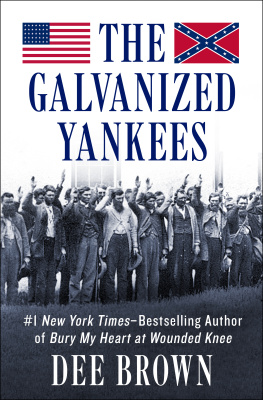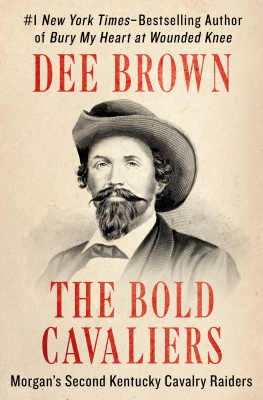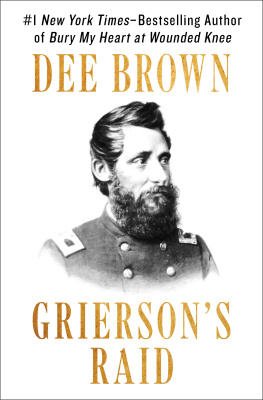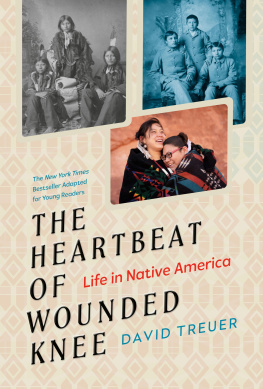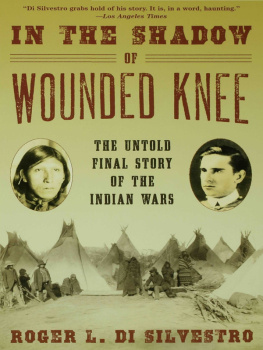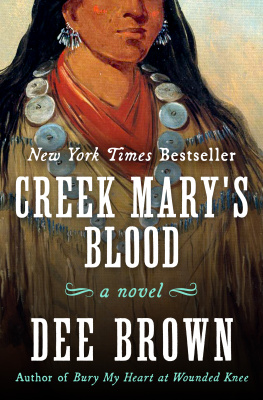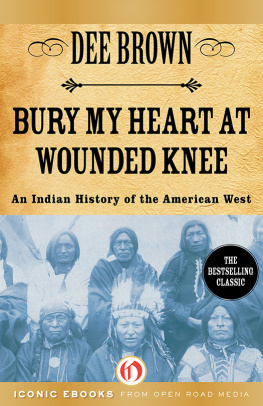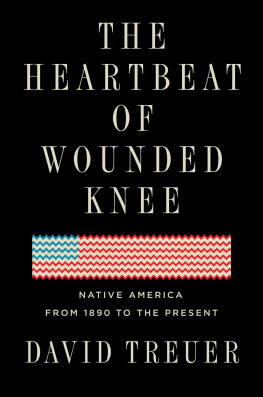Dee Brown - Wounded Knee: An Indian History of the American West
Here you can read online Dee Brown - Wounded Knee: An Indian History of the American West full text of the book (entire story) in english for free. Download pdf and epub, get meaning, cover and reviews about this ebook. year: 1993, publisher: Henry Holt and Co. (BYR), genre: Politics. Description of the work, (preface) as well as reviews are available. Best literature library LitArk.com created for fans of good reading and offers a wide selection of genres:
Romance novel
Science fiction
Adventure
Detective
Science
History
Home and family
Prose
Art
Politics
Computer
Non-fiction
Religion
Business
Children
Humor
Choose a favorite category and find really read worthwhile books. Enjoy immersion in the world of imagination, feel the emotions of the characters or learn something new for yourself, make an fascinating discovery.

Wounded Knee: An Indian History of the American West: summary, description and annotation
We offer to read an annotation, description, summary or preface (depends on what the author of the book "Wounded Knee: An Indian History of the American West" wrote himself). If you haven't found the necessary information about the book — write in the comments, we will try to find it.
Wounded Knee: An Indian History of the American West — read online for free the complete book (whole text) full work
Below is the text of the book, divided by pages. System saving the place of the last page read, allows you to conveniently read the book "Wounded Knee: An Indian History of the American West" online for free, without having to search again every time where you left off. Put a bookmark, and you can go to the page where you finished reading at any time.
Font size:
Interval:
Bookmark:
BURY MY HEART AT WOUNDED KNEE
An Indian History of the American West
Dee Brown
1970
forNicolas Brave Wolf
CONTENTS
List of Illustrations
Chapter Two
1. Manuelito 17
2. Juanita, wife of Manuelito 19
3.Navaho warrior of the 1860's 35
Chapter Three
4. Little Crow 41
5. BigEagle 49
Chapter Four
6.Cheyenne and Arapaho Chiefs in Denver 81
7.Little Raven 85
8. George Bent and his wifeMagpie 93
9. Edmond Guerrier 95
Chapter Five
10. Red Cloud109
Chapter Six
11.Spotted Tail 127
Chapter Seven
12.Roman Nose 155
13. Tosawi 171
ChapterEight
14. Donehogawa (Ely Parker) 181
Chapter Nine
15. Cochise 195
16. Eskiminzin 203
ChapterTen
17. Captain Jack 223
ChapterEleven
18. Satanta
19.Lone Wolf
20. Kicking Bird
21.Ten Bears
22. White Horse
23.Quanah Parker
Chapter Twelve
24.Sitting Bull
25. Gall
26.Two Moon
27. Hump
28.Crow King
29. Young-Man-Afraid-of-His-Horses
30. Little Big Man
31. CrazyHorse
Chapter Thirteen
32.Chief Joseph
Chapter Fourteen
33.Dull Knife
34. Little Wolf
ChapterFifteen
35. Standing Bear
ChapterSixteen
36. Ouray
37.Nicaagat (Jack)
38. Quinkent (Douglas)
39. Colorow
ChapterSeventeen
40. Geronimo
41.Naiche and his wife
42. Victorio
43.Nana
Chapter Eighteen
44.Wovoka, the Paiute Messiah
45. Kicking Bear
46. Short Bull
47. JohnGrass
Chapter Nineteen
48.Big Foot in death
49. Red Cloud in old age
Introduction
SINCE the exploratory journey of Lewis and Clark tothe Pacific Coast early in the nineteenth century, the number ofpublished accounts describing the "opening" of the AmericanWest has risen into the thousands. The greatest concentration ofrecorded experience and observation came out of the thirty-year spanbetween 1860 and 1890--the period covered by this book. It was anincredible era of violence, greed, audacity, sentimentality,undirected exuberance, and an almost reverential attitude toward theideal of personal freedom for those who already had it.
During that time the culture and civilization of theAmerican Indian was destroyed, and out of that time came virtuallyall the great myths of the American West--tales of fur traders,mountain men, steamboat pilots, goldseekers, gamblers, gunmen,cavalrymen, cowboys, harlots, missionaries, schoolmarms, andhomesteaders. Only occasionally was the voice of an Indian heard, andthen more often than not it was recorded by the pen of a white man.The Indian was the dark menace of the myths, and even if he had knownhow to write in English, where would he have found a printer or apublisher?
Yet they are not all lost, those Indian voices of thepast. A few authentic accounts of American western history wererecorded by Indians either in pictographs or in translated English,and some managed to get published in obscure journals, pamphlets, orbooks of small circulation. In the late nineteenth century, when thewhite man's curiosity about Indian survivors of the wars reached ahigh point, enterprising newspaper reporters frequently interviewedwarriors and chiefs and gave them an opportunity to express theiropinions on what was happening in the West. The quality of theseinterviews varied greatly, depending upon the abilities of theinterpreters, or upon the inclination of the Indians to speak freely.Some feared reprisals for telling the truth, while others delightedin hoaxing reporters with tall tales and shaggy-dog stories.Contemporary newspaper statements by Indians must therefore be readwith skepticism. although some of them are masterpieces of irony andothers burn with outbursts of poetic fury.
Among the richest sources of first-person statementsby Indians are the records of treaty councils and other formalmeetings with civilian and military representatives of the UnitedStates government. Isaac Pitman's new stenographic system was cominginto vogue during the second half of the nineteenth century, and whenIndians spoke in council a recording clerk sat beside the officialinterpreter.
Even when the meetings were in remote parts of theWest, someone usually was available to write down the speeches, andbecause of the slowness of the translation process, much of what wassaid could be recorded in longhand. Interpreters quite often werehalf-bloods who knew spoken languages but seldom could read or write.Like most oral peoples they and the Indians depended upon imagery toexpress their thoughts, so that the English translations were filledwith graphic similes and metaphors of the natural world. If aneloquent Indian had a poor interpreter, his words might betransformed to flat prose, but a good interpreter could make a poorspeaker sound poetic. Most Indian leaders spoke freely and candidlyin councils with white officials, and as they became moresophisticated in such matters during the 1870's and 1880's, theydemanded the right to choose their own interpreters and recorders. Inthis latter period, all members of the tribes were free to speak, andsome of the older men chose such opportunities to recount events theyhad witnessed in the past, or to sum up the histories of theirpeoples. Although the Indians who lived through this doom period oftheir civilization have vanished from the earth, millions of theirwords are preserved in official records. Many of the more importantcouncil proceedings were published in government documents andreports.
Out of all these sources of almost forgotten oralhistory, I have tried to fashion a narrative of the conquest of theAmerican West as the victims experienced it, using their own wordswhenever possible. Americans who have always looked westward whenreading about this period should read this book facing eastward.
This is not a cheerful book, but history has a way ofintruding upon the present, and perhaps those who read it will have aclearer understanding of what the American Indian is, by knowing whathe was. They may be surprised to hear words of gentle reasonablenesscoming from the mouths of Indians stereotyped in the American myth asruthless savages. They may learn something about their ownrelationship to the earth from a people, who were trueconservationists. The Indians knew that life was equated with theearth and its resources, that America was a paradise, and they couldnot comprehend why the intruders from the East were determined todestroy all that was Indian as well as America itself.
And if the readers of this book should ever chance tosee the poverty, the hopelessness, and the squalor of a modern Indianreservation, they may find it possible to truly understand the
reasons why.
DEE BROWN
Urbana, Illinois
April, 1970
I shall not be there. I shall rise andpass.
Bury my heart at Wounded Knee.
---- Stephen Vincent Benet----
ONE
"Their Manners Are Decorous andPraiseWorthy"
Where today are the Pequot? Where are theNarragansett, the Mohican, the Pokanoket, and many other oncepowerful tribes of Our people? They have vanished before the avariceand the oppression of the White Man, as snow before a summer sun. Will we let ourselves be destroyed in ourturn without a struggle, give up our homes, our country bequeathed tous by the Great Spirit, the graves of our dead and everything that isdear and sacred to us? I know you will cry with me, "Never!Never."Next page
Font size:
Interval:
Bookmark:
Similar books «Wounded Knee: An Indian History of the American West»
Look at similar books to Wounded Knee: An Indian History of the American West. We have selected literature similar in name and meaning in the hope of providing readers with more options to find new, interesting, not yet read works.
Discussion, reviews of the book Wounded Knee: An Indian History of the American West and just readers' own opinions. Leave your comments, write what you think about the work, its meaning or the main characters. Specify what exactly you liked and what you didn't like, and why you think so.

